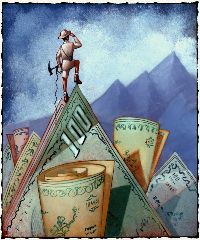 U.S. stock markets have been off to a very rough start in 2008, with all of the major indices — the Dow, Nasdaq, S&P 500, and Russell 2000 — significantly below their record closing values in October, 2007.
U.S. stock markets have been off to a very rough start in 2008, with all of the major indices — the Dow, Nasdaq, S&P 500, and Russell 2000 — significantly below their record closing values in October, 2007.
As a distraction from logging in to my brokerage account and staring at red down arrows, I wanted to pass along a little piece written this afternoon by David Gaffen at The Wall Street Journal detailing just how far the markets could fall:
By now the Standard & Poor’s 500-stock index has achieved something that hadn’t happened since 2002 — it is sitting at levels below the previous year’s lowest closing level, which some technicians view as a bearish signal.
The S&P 500’s lowest close in 2007 was 1374.12; the index finished below that level yesterday, and today, barring a miraculous turnaround, it will leave stocks below the intraday low in 2007, which was 1363.98. Todd Salamone of Schaeffer’s Investment Research says the action in the S&P is “an indication of a change in the trend,” noting that it hasn’t happened since 2002.
The Dow isn’t quite there — 2007’s closing low was 12050.41, and the index was currently traded at 12318. But analysts at Asbury Research see other technical problems on the Dow, noting that the recent closes below 12518 suggest “a larger, more sustainable top is in place in the Dow at the October 2007 high.”
They’re putting a downside target on the Dow of about 11,025, which suggests this is “the beginning of a bear market, not just a correction within the 2002 cyclical uptrend.”

